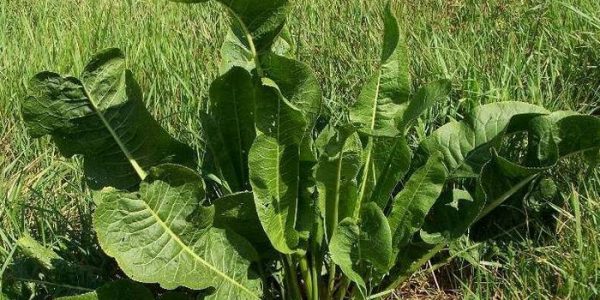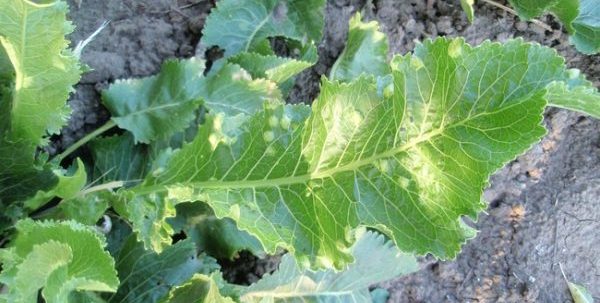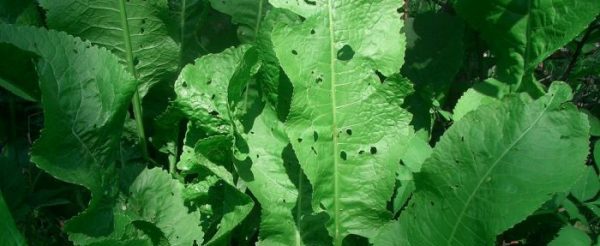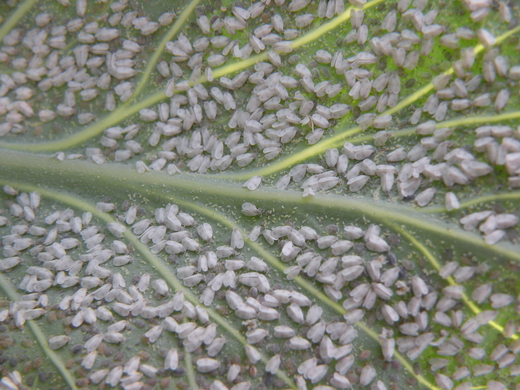What are horseradish leaf diseases and how to get rid of them
Content
Horseradish leaf beetle
This vegetable is a valuable medicinal crop, native to the southeast of the European part of Russia. It is grown for the sake of a cylindrical, weighty and fleshy rhizome, which is used as a food and spice plant. Horseradish root has a pungent and pungent specific odor. It tastes sweet at first, later it becomes hot and pungent.
Horseradish pests include babanukha or horseradish leaf beetle. Adults and larvae love to gnaw on its leaves. Such beetles are pests 3-4 cm long, oblong-oval in shape with a convex back and dark green elytra. Females tend to lay eggs in the eaten pulp and flood them with secretions. The larvae live in groups and harm horseradish for about 3 weeks. Cloudy weather and air humidity up to 100% are favorable for their life. Pupation of the larva takes place in the ground.
The fight against them involves the destruction of diseased crops, deep digging of the soil, spraying with insecticidal preparations. Fury's remedy has proven itself well - it must be used at the rate of 1 ampoule per 10 liters of water. Collecting parasites is advised by hand. From folk remedies, the use of wood ash in combination with hot red pepper and dry mustard is popular. With such a composition at the rate of 1 glass of ash and 1 teaspoon of pepper and mustard each, horseradish should be powdered.
Video "Useful and medicinal properties of horseradish"
Informational video about the benefits and medicinal properties of horseradish.
White rot
Another of the pests for the normal growth of horseradish is a dangerous infectious fungal disease - white rot. For the development of this disease, horseradish requires good moisture in the soil and air. Disease spores are usually carried along with the wind, spread through planting materials, weeds. The richness of nitrogen in the soil and the excessive density of horseradish plantings are favorable for them.
The fight against this disease includes the use of fungicides containing copper Cu. Bordeaux liquid is also suitable. Against such a disease, which occurs in horseradish, use drugs of contact action Ditan M-45, Profit, Rovral, which can not always help. It is recommended to treat horseradish with agents related to systemic contact fungicides - Ordan, Previkur, Profit Gold, Acrobat MC, Ridomil Gold MC. Prevention - weed control, destruction of affected crops, plowing the land in autumn, liming of acidic soil, balanced composition of mineral dressings.
Belle
One of the diseases that affect not only horseradish, but also cabbage, radishes and other crops. Those leaves, stems, testes and pedicels of horseradish, which have undergone this most dangerous of the diseases, turn out to be covered with white oil paint. As this ailment develops, horseradish tissues acquire a brown tint and dry out. The leaflets look swollen and deformed as virus spores form on them.Methods for controlling the disease include copper spraying.
Remnants of plant origin must be removed from the site. To prevent the disease, merciless destruction of weeds should be carried out in the process of horseradish growth and adhere to the crop rotation rate.
Wavy flea
Another pest that prefers to eat horseradish is the wavy flea. It is a black beetle with yellow stripes on the elytra. The body length of the insect is 3 mm. Such pests attack crops in early spring. Females lay eggs on the surface of the earth, from which offspring appear after 10 days. Such bugs eat holes in the leaves. In addition to horseradish, they feast on radishes, turnips, cabbage, watercress, daikon.
To get rid of parasites, it is necessary to treat the plants with Octellic or Foksim. For the first time, it is better to carry out processing during the period of emergence of sprouts, the second time - at the beginning of budding, and the finishing one - after the crops have run out of flowering time. It is permissible to use vegetable insecticides, among which tobacco products are recognized as effective. For prophylaxis, weeds and plant residues after harvesting are removed from the area where the culture grows, and loose leaves are raked into a heap. To disrupt the process of pupation of a wavy flea, it is recommended to loosen the ground around the plants. It will not be superfluous to treat the seeds before planting with high-quality dressing agents.
Cabbage moth
Another of the pests that often attack horseradish is the cabbage moth butterfly. It has dirty yellow wings with brown stripes and a dark spot, about 26 mm long. The caterpillar is an insect with a light brown head, yellowish-green body, light stripes in the back, its length reaches 17–19 mm. The habitat of such pests is Siberia, the Far East, the Caucasus. The caterpillars spend winter in the ground in a special cocoon, which is lined with cobwebs inside, and covered with parts of the soil outside.
The cabbage moth is a moth that is rarely seen during the day. She prefers to lay eggs on the underside of the leaves in groups of several. Caterpillars emerge from them after 8-10 days. They like to gnaw the flesh of the leaves from the bottom. Grown-up individuals eat through holes in the foliage surface. They live from 14 to 35 days - much depends on the weather. Then they descend underground, where they develop as pupae.
The fight against these enemies of normal horseradish development includes insecticidal spraying and dusting. This is done in the spring, when insects begin their destructive life. For the prevention of the disease, it is important to destroy the weeds in time, which are the breeding centers of the cabbage moth.
Video "Horseradish in the Garden"
Demonstration video about a plant called horseradish.





